For the 2025 school year, there are 2 public elementary schools serving 820 students in Newton ÎÛÎÛÂþ» School District. This district's average elementary testing ranking is 3/10, which is in the bottom 50% of public elementary schools in New Jersey.
ÎÛÎÛÂþ» Elementary Schools in Newton ÎÛÎÛÂþ» School District have an average math proficiency score of 23% (versus the New Jersey public elementary school average of 37%), and reading proficiency score of 43% (versus the 49% statewide average).
Minority enrollment is 55% of the student body (majority Hispanic), which is less than the New Jersey public elementary school average of 63% (majority Hispanic).
Overview
This School District
This State (NJ)
# Schools
3 Schools
1,930 Schools
# Students
1,543 Students
886,629 Students
# Teachers
142 Teachers
77,858 Teachers
Student : Teacher Ratio
11:1
11:1
District Rank
Newton ÎÛÎÛÂþ» School District, which is ranked within the bottom 50% of all 646 school districts in New Jersey (based off of combined math and reading proficiency testing data) for the 2021-2022 school year.
The school district's graduation rate of 85-89% has stayed relatively flat over five school years.
Overall District Rank
#440 out of 650 school districts
(Bottom 50%)
(Bottom 50%)

Math Test Scores (% Proficient)
24%
36%
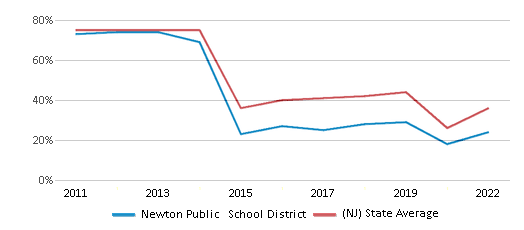
Reading/Language Arts Test Scores (% Proficient)
45%
49%
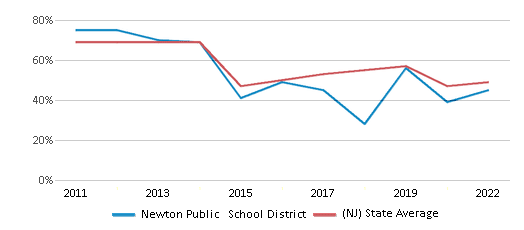
Science Test Scores (% Proficient)
15%
23%
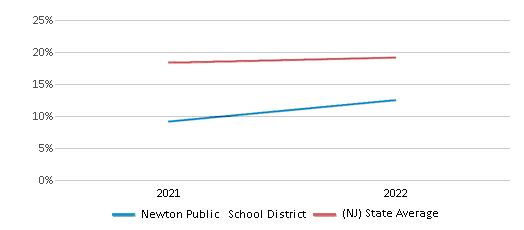
Graduation Rate
85-89%
85%
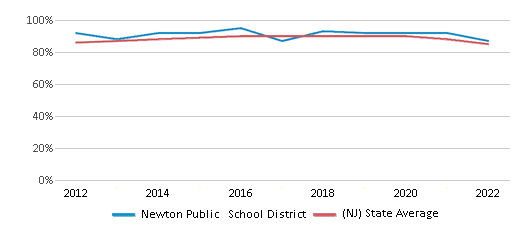
Students by Ethnicity:
Diversity Score
0.61
0.72
# American Indian Students
3 Students
1,992 Students
% American Indian Students
n/a
n/a
# Asian Students
45 Students
92,318 Students
% Asian Students
3%
10%
# Hispanic Students
531 Students
301,752 Students
% Hispanic Students
34%
34%
# Black Students
111 Students
132,335 Students
% Black Students
7%
15%
# White Students
798 Students
325,482 Students
% White Students
52%
37%
# Hawaiian Students
2 Students
1,690 Students
% Hawaiian Students
n/a
n/a
# Two or more races Students
53 Students
30,907 Students
% of Two or more races Students
4%
4%
Students by Grade:
# Students in PK Grade:
77
41,362
# Students in K Grade:
84
85,425
# Students in 1st Grade:
108
93,943
# Students in 2nd Grade:
89
96,713
# Students in 3rd Grade:
82
95,865
# Students in 4th Grade:
84
97,373
# Students in 5th Grade:
80
98,202
# Students in 6th Grade:
74
99,575
# Students in 7th Grade:
66
80,278
# Students in 8th Grade:
76
80,823
# Students in 9th Grade:
191
4,713
# Students in 10th Grade:
164
4,047
# Students in 11th Grade:
190
3,770
# Students in 12th Grade:
178
4,350
# Ungraded Students:
-
190
District Revenue and Spending
The revenue/student of $23,942 in this school district is less than the state median of $26,931. The school district revenue/student has stayed relatively flat over four school years.
The school district's spending/student of $24,230 is less than the state median of $25,828. The school district spending/student has stayed relatively flat over four school years.
Total Revenue
$37 MM
$36,642 MM
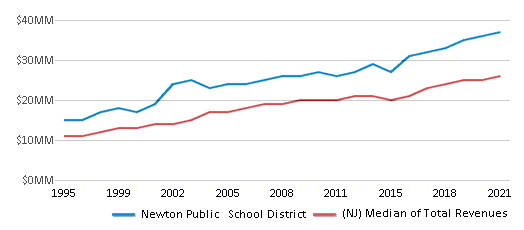
Spending
$37 MM
$35,142 MM

Revenue / Student
$23,942
$26,931
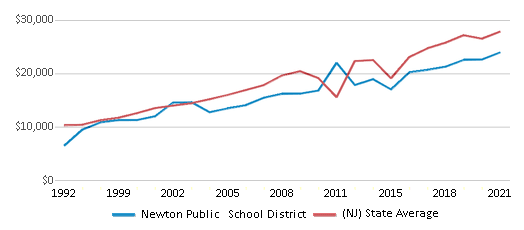
Spending / Student
$24,230
$25,828
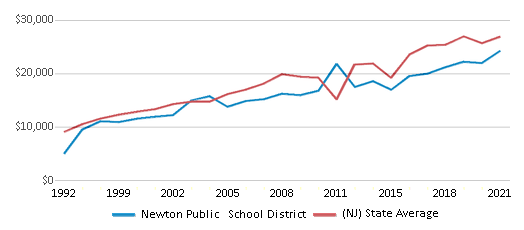
Best Newton ÎÛÎÛÂþ» School District ÎÛÎÛÂþ» Elementary Schools (2025)
School
(Math and Reading Proficiency)
(Math and Reading Proficiency)
Location
Grades
Students
Rank: #11.
Merriam Avenue School
(Math: 35-39% | Reading: 50-54%)
Rank:
Rank:
6/
Top 50%10
81 Merriam Avenue
Newton, NJ 07860
(973) 383-7202
Newton, NJ 07860
(973) 383-7202
Grades: PK-4
| 524 students
Rank: #22.
Halsted Middle School
(Math: 17% | Reading: 39%)
Rank:
Rank:
3/
Bottom 50%10
59 Halsted Street
Newton, NJ 07860
(973) 383-7440
Newton, NJ 07860
(973) 383-7440
Grades: 5-8
| 296 students
Recent Articles

Year-Round Or Traditional Schedule?
Which is more appropriate for your child? A year-round attendance schedule or traditional schedule? We look at the pros and cons.

Why You Should Encourage Your Child to Join a Sports Team
Participating in team sports has a great many benefits for children, there is no doubt. In this article you will learn what those benefits are.

White Students are Now the Minority in U.S. ÎÛÎÛÂþ» Schools
Increasing birth rates among immigrant families from Asia and Central and South America, combined with lower birth rates among white families, means that for the first time in history, public school students in the United States are majority-minority. This shift in demographics poses difficulties for schools as they work to accommodate children of varying language abilities and socio-economic backgrounds.





